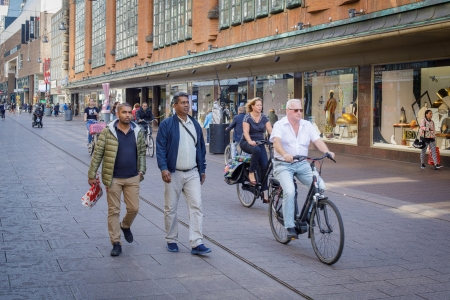At specific locations and times of day, particularly in major cities, the width of bicycle tracks is insufficient for the number of users. Whether congestion on bicycle tracks adversely affects cyclists’ road safety is unknown. A letter to the Dutch Lower House of Parliament states that possible problems caused by congestion on bicycle tracks strongly differ between regions [49]. Parties that have questioned the minister of Infrastructure and Water Management [49] on this issue, indicate that the experienced congestion is often caused by speed differences between the users of bicycle tracks, for example between bicycles and light mopeds, which is especially relevant in major cities (also see the question What is safer for light mopeds, carriageway or bicycle track? ) and between cyclists and racing bikers on recreational bicycle tracks. SWOV research has shown that there is indeed a great variety of road users on bicycle tracks [50]. Light mopeds are faster and wider than standard bicycles, and an overwhelming majority ride faster than permitted (25 km/h) [51] and overtake other road users more often.
On bicycle tracks, traditional city bikes are used by about 90% of cyclists. The number of pedelecs is increasing, but, in speed, they differ less from traditional city bikes than light mopeds do (see the question How big a problem is the difference in speed, mass and size of vehicles on bicycle tracks? ). The large share of traditional city bikes determines behaviour on bicycle tracks when they are crowded. That is why at crowded locations speed varies less than at quiet locations [50] and why fewer cyclists ride against the compulsory direction illicitly [44]. According to CROW guidelines [4] minimal widths of bicycle tracks should depend on the number of cyclists that use them. In major cities, and at specific locations and times of day, the width of the bicycle track is insufficient [50] [52] but crash studies into the correlation between congestion and safety on bicycle tracks are not available yet. For now, without new research, congestion is a subjective concept. Mention is also made of ‘Perceived congestion’, which depends on individual, social and physical factors. Congestion is mainly perceived to be a problem in major cities, and sometimes cyclists adapt their routes or their time of departure or even decide to choose a different mode of transport [53] [54].
